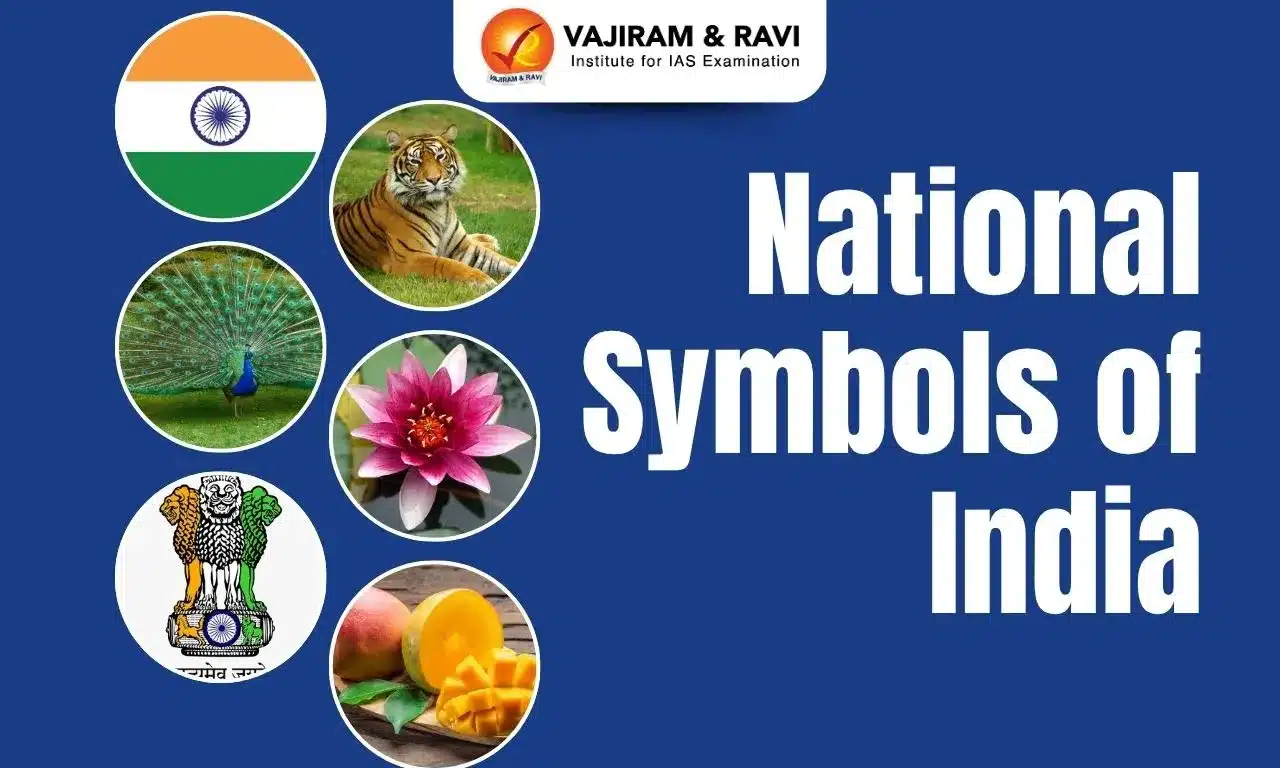National Symbols of India are an essential part of any nation’s identity, reflecting its cultural values and historical significance. For Indians, these 17 national symbols are not only a source of pride but also a representation of India’s diverse heritage. These symbols are integral to the country’s identity and are significant in the context of national importance, making it essential for every citizen to be familiar with them. In competitive exams such as UPSC, questions related to these 17 National Symbols of India are frequently asked. This article will include each of these symbols and explore their cultural and national relevance.
National Symbols of India
National Symbols of India serve as an important representation of our country’s values, history, and identity. India, with its rich cultural heritage and diverse traditions, has a set of national symbols that evoke pride, patriotism, and a deep sense of unity among its citizens. These symbols go beyond representations; they embody the collective spirit and heritage of the nation.
List of National Symbols of India
Check out the List of National Symbols of India below, which includes key symbols like the National Flag, Emblem, Anthem, along with the Bengal Tiger, Lotus, and the Ganges River. These symbols embody India’s cultural heritage, evoking patriotism, pride, and unity, while reflecting the country’s rich diversity and identity.
| List of National Symbols of India | ||
|
1 |
National Flag |
Tiranga |
|
2 |
National Emblem |
National Emblem of India |
|
3 |
National Currency |
Indian Rupees |
|
4 |
National Calendar |
Saka Calendar |
|
5 |
Oath of Allegiance |
National Pledge |
|
6 |
National River |
Ganga |
|
7 |
National Heritage Animal |
Indian Elephant |
|
8 |
National Animal |
Royal Bengal Tiger |
|
9 |
National Bird |
Indian Peacock |
|
10 |
National Tree |
Indian Banyan |
|
11 |
National Song |
Vande Mataram |
|
12 |
National Anthem |
Jana Gana Mana |
|
13 |
National Reptile |
King Cobra |
|
14 |
National Aquatic Animal |
Ganges River Dolphin |
|
15 |
National Vegetable |
Pumpkin |
|
16 |
National Fruit |
Mango |
|
17 |
National Flower |
Lotus |
National Symbols of India with Names List
Check below the Name List of National Symbols of India with a brief description.
Indian National Flag
The National Flag of India, known as the Tiranga, was designed by Pingali Venkayya and was officially adopted on 22nd July 1947. Its three colors, saffron, white, and green which symbolize the sacrifice of freedom fighters, peace, and prosperity respectively. The flag is a symbol of India’s unity, diversity, and pride.
National Flower of India
The National Flower of India is the Lotus, symbolizing purity, beauty, and spiritual enlightenment. It holds great cultural and religious significance in Indian traditions, often associated with gods and goddesses like Lakshmi and Saraswati. The lotus represents the idea of rising above challenges, just as it blooms beautifully even in muddy waters.
National Emblem
India’s National Emblem, derived from the Ashoka Chakra at Sarnath, reflects the nation’s history and cultural significance. The emblem carries the motto ‘Satyameva Jayate’, which means “Truth Alone Triumphs”, symbolizing India’s commitment to justice and righteousness.
National Currency
The currency of India is the Indian Rupee (INR), which is regulated by the Reserve Bank of India. Designed by Udayakumar Dharmalingam, the rupee symbol reflects India’s economic strength and heritage.
National Calendar
The Saka Calendar serves as India’s national calendar. With deep historical roots, it represents the golden period of Indian civilization and has been in use for official purposes since 1957.
Oath of Allegiance
The National Pledge of India is a declaration of allegiance to the nation, emphasizing unity, peace, and national integrity. This pledge is recited across schools and institutions to promote patriotism and a sense of belonging.
National Fruit of India
The mango holds the title of the National Fruit of India. Loved across the nation, it is a symbol of summer and prosperity. Known for its sweetness, the mango is a cultural icon in India.
National Animal of India
The Royal Bengal Tiger is India’s National Animal. Recognized for its strength and grace, the tiger is also a symbol of the nation’s commitment to conservation, as it faces the threat of extinction.
National Bird of India
The peacock is India’s National Bird, chosen for its beauty and significance in Indian culture. The bird was adopted in 1963, representing vibrancy, national pride, and cultural heritage.
National Anthem
India’s National Anthem, ‘Jana Gana Mana’, was composed by Rabindranath Tagore in Bengali and later translated into Hindi. It was officially adopted as the anthem in 1950, and its stirring lyrics reflect India’s diversity and unity.
National Song of India
‘Vande Mataram’, written by Bankim Chandra Chatterjee, is India’s National Song. Adopted in 1950, it celebrates the country’s freedom struggle and pays homage to India as a motherland.
National Tree of India
The banyan tree is India’s National Tree. Known for its vast canopy, the banyan is a symbol of immortality and spiritual significance in Hinduism, representing resilience and longevity.
National Vegetable of India
Pumpkin is the National Vegetable of India, chosen for its widespread cultivation and the vital role it plays in Indian diets. This versatile vegetable is grown across the country with minimal resources.
National Heritage Animal
The Indian Elephant is declared the National Heritage Animal of India. Revered in Indian culture, the elephant symbolizes strength and wisdom. Efforts are underway to protect this majestic animal as its population dwindles.
National Aquatic Animal of India
The Ganges River Dolphin is India’s National Aquatic Animal. This species, found in the Ganges River, is endangered, and its declaration as a national symbol aims to raise awareness for its conservation.
National River of India
In 2008, the Ganges was declared India’s National River, underscoring its deep cultural and spiritual significance. The Ganga Action Plan was initiated to protect and preserve this sacred river.
Significance of National Symbols of India
National symbols are essential to a country’s identity, values, and history, and they foster unity and pride. In India, symbols like the national flag, emblem, flower, bird, animal, and tree represent the country’s rich cultural heritage. These symbols not only evoke patriotism but also serve practical purposes—such as the national flag identifying Indian ships and aircraft, and the emblem appearing on official government documents.
The lotus, India’s national flower, symbolizes purity and spirituality, while the Bengal tiger, the national animal, represents strength and bravery. The peacock, recognized as the national bird, reflects grace and beauty, and the banyan tree, India’s national tree, signifies immortality.
Together, these symbols help unite the Indian people, promote cultural pride, and reinforce the country’s values both within India and internationally. They are more than just emblems—they inspire respect and celebrate the country’s unique identity.
Last updated on December, 2025
→ Check out the latest UPSC Syllabus 2026 here.
→ Join Vajiram & Ravi’s Interview Guidance Programme for expert help to crack your final UPSC stage.
→ UPSC Mains Result 2025 is now out.
→ UPSC Notification 2026 is scheduled to be released on January 14, 2026.
→ UPSC Calendar 2026 is released on 15th May, 2025.
→ The UPSC Vacancy 2025 were released 1129, out of which 979 were for UPSC CSE and remaining 150 are for UPSC IFoS.
→ UPSC Prelims 2026 will be conducted on 24th May, 2026 & UPSC Mains 2026 will be conducted on 21st August 2026.
→ The UPSC Selection Process is of 3 stages-Prelims, Mains and Interview.
→ UPSC Result 2024 is released with latest UPSC Marksheet 2024. Check Now!
→ UPSC Prelims Result 2025 is out now for the CSE held on 25 May 2025.
→ UPSC Toppers List 2024 is released now. Shakti Dubey is UPSC AIR 1 2024 Topper.
→ UPSC Prelims Question Paper 2025 and Unofficial Prelims Answer Key 2025 are available now.
→ UPSC Mains Question Paper 2025 is out for Essay, GS 1, 2, 3 & GS 4.
→ UPSC Mains Indian Language Question Paper 2025 is now out.
→ UPSC Mains Optional Question Paper 2025 is now out.
→ Also check Best IAS Coaching in Delhi
National Symbols of India 2025 FAQs
Q1. What are the 17 National Symbols of India?+
Q2. What is the name of the National Symbol?+
Q3. What do the National Symbols of India represent?+
Q4. What are the names of 5 of the National Symbols?+
Q5. Which is the National Tree?+

















